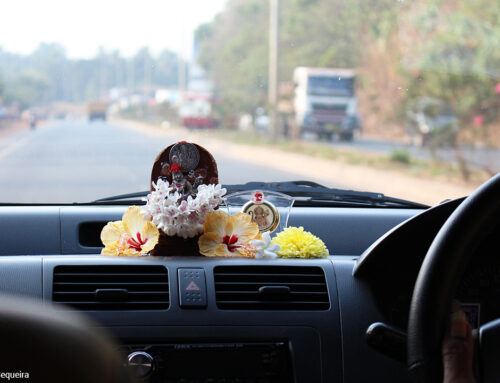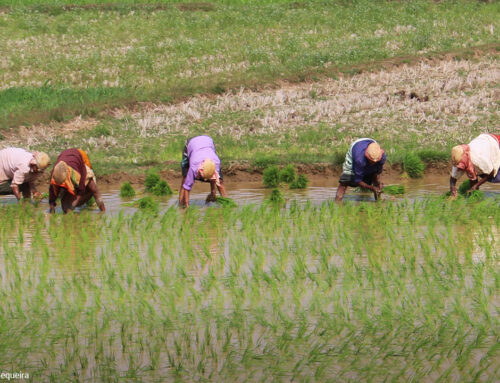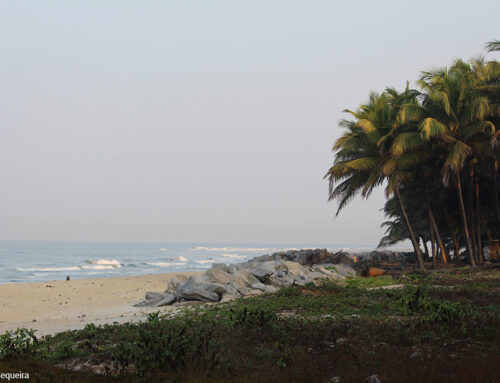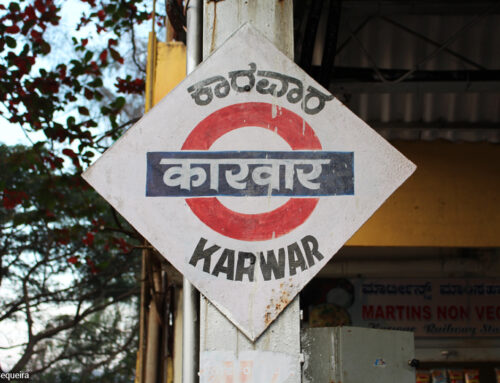There it stood – or floated in the mist – plumb in the middle of the Arabian sea, off the coast of Malvan. It was just a short boat ride away from Malvan beach – the place where we had witnessed an amazing seafood auction at dawn. This majestic marvel seemed to be beckoning us, beguiling us. So we wasted no time in finding the boat service that would haul us over the waves, jammed amidst many tourists whose excitement was as palpable as ours!
Sindhudurg Fort is one of the many forts built by the Maratha chief, Chhatrapati Shivaji. Built over a period of three years, this 17th century sea fort is sprawled over 48 acres, with a 3 km long rampart, and walls that are 30 feet high and 12 feet thick. The massive walls were designed as a deterrent to approaching enemies, and to the waves of the Arabian Sea that could get menacingly huge during the Monsoons. Located on a small islet, it took 3 years, 100 architects and a manpower of 3000 to build this engineering marvel! As our boat approached the fort, we could not spot the main entrance – designed to stay well-concealed. Walking the perimeter of this amazing fort, we found 3 temples, including one temple dedicated to Shivaji. Under the temple resembling a water reservoir, is a hidden passage that travels under the fort for 3 kilometres, then 12 kilometres beneath the sea and from there 12 kilometres to a nearby village which was used as an evacuation route for women and children, in case of an attack. We, meanwhile, were attacked by hawkers and shopkeepers, trying to sell sunglasses, hats and umbrellas among other things – all made in China, which have made their way to the Fort the same way we did.
What we found even more amazing was that around 15 families still lived in the fort, all inheritors of the land from the 17th century. 3 fresh water wells supplied their drinking water. They suffered adventure seekers and scuba divers during the tourist season. And then, during the monsoons, they are cut off from the main land, left to fend for themselves. A harsh life in the midst of all that beauty!
We made our way to the jetty to get back to Malvan, and to a lunch that was being prepared for us on pristine Achra beach, a short drive away. Driving through narrow streets and sharp turns, we arrived at Shree Resort and Tourism, run by a family that has lived here for generations.. It’s really pot-luck. You get to eat, what they get to catch on that day. Unlike the west, where ‘cooking from scratch’ can put you on a pedestal, in Indian villages, it’s an everyday phenomenon. Cooking began as soon as we arrived. It was a joy to see the masala being ground on a stone, by the lady of the house, her green bangles tinkling through the entire process. She then cooked al fresco on a make-shift ‘chula’ or stove. She prepared a ‘bangda tikla’ (mackeral curry) by sauteing onion in oil, in a clay pot or ‘kundlem’. My grandmother always insisted that curries worth their salt should be prepared in clay pots. She then added the bright orange freshly ground and spiced coconut paste to it, before popping in the mackeral. Of course, no curry is complete without ‘kokam’ (garcinia indica). While the curry bubbled, she spiced and fried thick slices of kingfish. The gentle breeze carried the fishy fragrance to my hammock, which was tied to 2 coconut trees, and where I was trying to desperately ignore my hunger pangs. Alan tried his luck climbing a coconut tree and almost succeeded. My brother and Mahesh the videographer, strolled the wide, desolate Achra beach which seemed in want of some human company. A lighthouse on a hill in the distance looked even lonelier! Meanwhile, ‘bhakri’ or rice rotis were being freshly rolled out and baked on a ‘tava’ (pan) as accompaniment. Then, lunch was served. You’ve got to have the luck of the devil to be able to enjoy the culinary nexus that makes a Konkan meal complete: 1. Fish just brought in from the sea. 2. Fresh coconut ground on a traditional grinding stone. 3. Food cooked and enjoyed al-fresco. This was heaven!
While we all ate hungrily with our fingers, even licking them – albeit, surreptitiously, the man of the house, Paresh Tari, told us a story that could be considered a fairy tale, were it not true! He narrated the ‘Gaon Palan’ story – a centuries-old ritual that takes place in Achra village. Every 3 or 4 years, the village literally runs away, deserting their homes for 3 nights and 4 days. Hindus and Christians take their cattle, pets, food, lock their houses and stay in tents outside the periphery of the village. From a bustling village, everything goes eerily quiet. No women drawing water at the well, no dog barking, no children playing in the fields, no old men buying beedies (rolled up cigarettes) at the shops. The village is completely deserted, with no living being seen anywhere. On the afternoon of the fourth day, they ask the deity of their temple for permission to re-enter and return to their daily hustle and bustle .It’s a centuries-old, unique tradition that is followed by a few neighbouring villages as well.
“But why?” we ask incredulously? They believe that if they don’t follow this ritual the water will be contaminated or an epidemic will afflict the village. They believe that if they leave the village for the evil spirits to roam freely for 3 nights, they will stop tormenting the village for 3 years. So they continue following this incredible ritual, which is now woven into their history.
The unforgettable al-fresco meal and the story of the runaway village stayed with us, all the way to Goa, which was our next destination. Here, I would be haunted again – by childhood memories and a way of life that was fast fading.
Stay tuned for the next chapter!
For photographs go to the Photo Gallery tab above; likewise for recipes.
Best time to visit: November – March
Know your Konkan Coast

The Konkan coast runs south from Mumbai all the way to Kasargod. Quaint fishing villages and magnificent forts look out into the endless blue of the Arabian sea. Pristine beaches and coconut palm trees dot the coast all along, until you reach Malvan, the last beach town of significance, before the sands dissolve into Goa. The cuisine along the Konkan coast is as varied as it is delicious, greatly influenced by its geographic location, and layered history of the region. They are all intertwined yet distinct. Some patterns are common – like the seasons which influenced bottling pickles, and drying of fish and pork etc. The monsoon brought a lot of seasonal foods like bamboo, snails (conge) etc to the table. Coconut is an integral part of the Konkan cuisine. Apart from local influences, Portuguese and Arab influences had major impacts.








